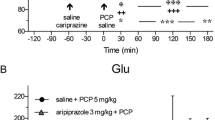Abstract.
The low incidence of extrapyramidal effects with atypical neuroleptics has been ascribed to their 5-HT2A- and 5-HT2C-serotonin receptor antagonistic properties. On the other hand, the acute increase in striatal dopamine release by submaximal dopamine D2 autoreceptor blockade can be respectively reduced and increased by 5-HT2A- and 5-HT2C-antagonists. Cyamemazine is a neuroleptic D2- and 5-HT2A-receptor antagonist, with small antagonistic activity at 5-HT2C receptors and low incidence of extrapyramidal side effects. Therefore, submaximal cyamemazine was tested in rats for its acute action on the extracellular concentrations of dopamine and dopamine metabolites (DOPAC: 3,4,dihydroxyphenylacetic acid and HVA: 4-hydroxy-3-methoxy-phenyl-acetic acid) in the corpus striatum. The serotonin metabolite 5-HIAA (5-hydroxy-indole-acetic acid) was measured in parallel. Rats prepared for microdialysis (striatum) were intraperitoneally given cyamemazine 1 mg/kg, 5 mg/kg or vehicle (n=4 in each group). Dopamine, DOPAC, HVA and 5-HIAA concentrations in perfusates under basal conditions and after stimulation by high K+ were measured by HPLC coupled to electrochemical detection. Cyamemazine 1 mg/kg significantly reduced extracellular concentrations of basal dopamine (−77%), DOPAC (−54%), HVA (−54%) and 5-HIAA (−65%). No such effects were seen with the dose of cyamemazine 5 mg/kg or for K+-evoked dopamine release. In conclusion, submaximal cyamemazine can acutely reduce basal dopamine release and metabolism in the rat striatum. Such unusual action can be explained by the original pharmacological profile of cyamemazine (potent D2- and 5-HT2A-antagonist, with small antagonistic activity at 5-HT2C receptors). Further experiments are required to explain the low incidence of extrapyramidal side actions with cyamemazine.




Similar content being viewed by others
References
Alcantara AG, Barcia D (1999) Risperidone and concept of bipolar neuroleptic. Encephale 25:146–150
Alvarez-Guerra M, d'Alché-Birée F, Wolf WA, Vargas F, Dib M, Garay RP (2000) 5-HT3- and 5-HT2C-receptor antagonist properties of cyamemazine: significance for its clinical anxiolytic activity. Psychopharmacology 147:412–417
Alvarez-Guerra M, Hameg A, Dib M, Garay RP (2002) 5-HT2A-receptor antagonist properties of cyamemazine in rat and guinea pig smooth muscle. Eur J Pharmacol 454:235–239
Bhana N, Foster RH, Olney R, Plosker GL (2001) Olanzapine: an updated review of its use in the management of schizophrenia. Drugs 61:111–161
Bourin M, Dhonnchadha BAN, Colombel MC, Dib M, Hascoët M (2001) Cyamemazine as an anxiolytic drug on the elevated plus maze and light/dark paradigm in mice. Behav Brain Res 124:87–95
De Klippel N, Sarre S, Ebinger G, Michotte Y (1993) Effect of M1- and M2-muscarinic drugs on striatal dopamine release and metabolism: an in vivo microdialysis study comparing normal and 6-hydroxydopamine-lesioned rats. Brain Res 630:57–64
Di Matteo V, De Blasi A, Di Giulio C, Esposito E (2001) Role of 5-HT2C receptors in the control of central dopamine function. Trends Pharmacol Sci 22:229–232
Di Matteo V, Cacchio M, Di Giulio C, Di Giovanni G, Esposito E (2002) Biochemical evidence that the atypical antipsychotic drugs clozapine and risperidone block 5)HT(2C) receptors in vivo. Pharmacol Biochem Behav 71:607–613
Dubroca JM (1989) L'anxiolyse: intérêt de la cyamémazine. Neuro-Psy :4–7
Dyr W, Kostowski W (1997) Effects of 5-HT3 receptor agonists on voluntary ethanol intake in rats maintained on a limited access procedure. Alcool 32:455–462
Garay RP, d'Alché-Birée F (1995) Cyamémazine (Tercian®): profil neuroleptique ou anxiolytique ?. Inf Psychiatr 10:969–970
Hernandez L, Hoebel BG (1995) Chronic clozapine selectively decreases prefrontal cortex dopamine as shown by simultaneous cortical, accumbens, and striatal microdialysis in freely moving rats. Pharmacol Biochem Behav 52:581–589
Herrick-Davis K, Grinde E, Teitler M (2000) Inverse agonist activity of atypical antipsychotic drugs at human 5-hydroxytryptamine 2C receptors. J Pharmacol Exp Ther 295:226–232
Ichikawa J, Meltzer HY (1995) DOI, a 5-HT2A/2C receptor agonist, potentiates amphetamine-induced dopamine release in rat striatum. Brain Res 698:204–208
Invernizzi R, Pozzi L, Samanin R (1995) Selective reduction of extracellular dopamine in the rat nucleus accumbens following chronic treatment with DAU 6215, a 5-HT3 receptor antagonist. Neuropharmacology 34:211–215
Julou L, Ducrot R, Fournel J, Leau O, Bardone MC, Myon J (1961) Etude des propriétés pharmacologiques de la cyano-3 (diméthyl-3' méthyl-2 propyl)-10 phénotiazine ou cyamépromazine (7.204 R.P.) Comptes Rendus Soc Biol 155:1029–1034
Lidow MS, Goldman-Rakic PS (1997) Differential regulation of D2 and D4 dopamine receptor mRNAs in the primate cerebral cortex vs. neostriatum: effects of chronic treatment with typical and atypical antipsychotic drugs. J Pharmacol Exp Ther 283:939–946
Lucas G, De Deurwaerdère, Caccia S, Spampinato U (2000) The effect of serotoninergic agents on haloperidol-induced striatal dopamine release in vivo: opposite role of 5-HT2A and HT2C receptor subtypes and significance of the haloperidol dose used. Neuropharmacology 39:1053–1063
Meltzer HY (1999) The role of serotonin in antipsychotic drug action. Neuropsychopharmacology 21 [Suppl 2]:106S–115S
Ng NK, Lee HS, Wong PT (1999) Regulation of striatal dopamine release through 5-HT1 and 5-HT2 receptors. J Neurosci Res 55:600–607
Pehek EA, Yamamoto BK (1994) Differential effects of locally administered clozapine and haloperidol on dopamine efflux in the rat prefrontal cortex and caudate-putamen. J Neurochem 63:2118–2124
Radat F (1995) Cyamémazine: traitement symptomatique des dimensions anxieuses, impulsives et agressives. Inf Psychiatr 10:967–968
Sibley DR (1999) New insights into dopaminergic receptor function using antisense and genetically altered animals. Annu Rev Pharmacol Toxicol 39:313–341
Sotnikova TD, Gainetdinov RR, Grekhova TV, Rayevsky KS (2001) Effects of intrastriatal infusion of D2 and D3 dopamine receptor preferring antagonists on dopamine release in rat dorsal striatum. Pharmacol Res 43:283–290
Starke K, Göthert M, Kilbinger H (1989) Modulation of neurotransmitter release by presynaptic autoreceptors. Physiol Rev 69:864–989
Strange PG (2001) Antipsychotic drugs: importance of dopamine receptors for mechanisms of therapeutic actions and side effects. Pharmacol Rev 53:119–133
Waters N, Lagerkvist S, Löfberg L, Piercey M, Carlsson A (1993) The dopamine D3 receptor and autoreceptor preferring antagonists (+)-AJ76 and (+)-UH232; a microdialysis study. Eur J Pharmacol 242:151–163
Acknowledgements.
We are greatly indebted to E. Garay (Pharmalex s.a., Paris, France), who helped with the coordination and monitoring of this study.
Author information
Authors and Affiliations
Corresponding author
Rights and permissions
About this article
Cite this article
Peinado, J., Hameg, A., Garay, R.P. et al. Reduction of extracellular dopamine and metabolite concentrations in rat striatum by low doses of acute cyamemazine. Naunyn-Schmiedeberg's Arch Pharmacol 367, 134–139 (2003). https://doi.org/10.1007/s00210-002-0665-4
Received:
Accepted:
Published:
Issue Date:
DOI: https://doi.org/10.1007/s00210-002-0665-4



